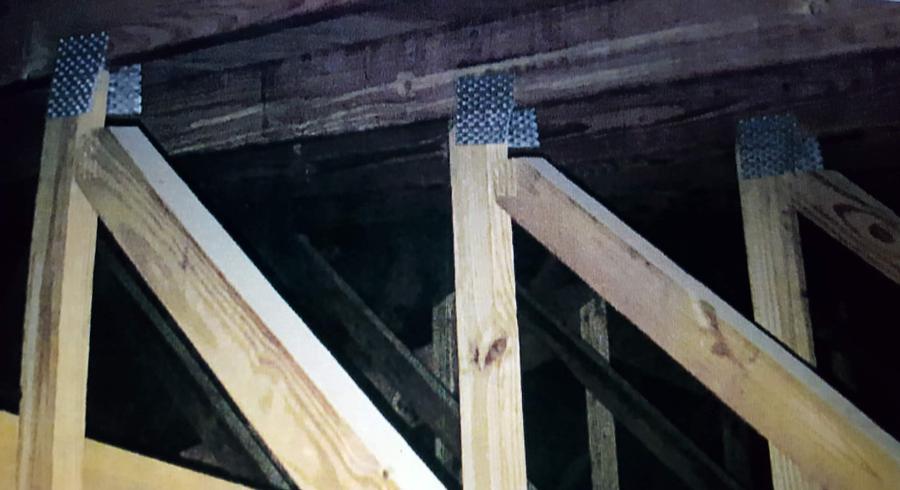Selectmen: Trusses Failing in Library
The view from the side of the other end of the bookshelves looks like the wood is pushing through the ceiling -- well, really the ceiling is collapsing down and over the wood. The wood is holding up the small piece of ceiling.
 Library Assistant Director Jennifer Keen noticed this area that appeared to be sagging and pushing down onto the bookcase upstairs in the back of the library near the seating area and window. Ultimately officials called Andy Barr of Russo Barr Associates, the engineering consultants that successfully handled the roof replacement project, which was done in the summer and is essentially complete. Barr attended the BOS meeting on Monday and said that the engineers took a look in the attic. HVAC contractors were up there, but they were in the front part of the building not in the back.
Library Assistant Director Jennifer Keen noticed this area that appeared to be sagging and pushing down onto the bookcase upstairs in the back of the library near the seating area and window. Ultimately officials called Andy Barr of Russo Barr Associates, the engineering consultants that successfully handled the roof replacement project, which was done in the summer and is essentially complete. Barr attended the BOS meeting on Monday and said that the engineers took a look in the attic. HVAC contractors were up there, but they were in the front part of the building not in the back.
Basically, the framing is a 56 foot wide clear span without columns supported by trapezoidal trusses. The ceiling is attached to the bottom of the trusses, which are two feet apart and attached with metal plates. The whole ceiling appears to have settled. In two locations equidistant from the center ridge of the roof, the diagonal beams have pulled away. The 2x4s are attached by nail plates, which are pulling away. The engineers would like to find the problem but all they have are schematics from 1985 when the addition was built.

"The design is not atypical of how these roofs are designed. A truss company does the final designs. Without the shop drawings of the trusses, we don't know what was supposed to have come from the manufacturer," Barr told the Selectmen.
Russo Barr Associates have done some analysis of the design drawings, which were done to the state's old building codes of 30 lbs. per square foot of live snow load. Later building codes required 35 lb. loads. Now the load limits are up to 50 lbs. psf because there is more weather data. Two of last five winters brought excessive snow – 40-60 lbs. psf snow loads. Holliston is in a zone of heavy snow.
When asked how long he thought the problem had been going on, Barr said it was possible that the heavy snow started to tear and move and spread the  plates apart, gradually over three to five years. Then the roofing job created motion on the roof and created new kind of movement. But the engineers had examined the problem area before doing roof and there was no visible problem at the time – and they were climbing over trusses.
plates apart, gradually over three to five years. Then the roofing job created motion on the roof and created new kind of movement. But the engineers had examined the problem area before doing roof and there was no visible problem at the time – and they were climbing over trusses.
Recent examinations show that the conditions are the same on the opposite side. Of the 14 trusses, 12 have problems. "It's a pretty robust building," Barr said. He assured the BOS that the Building Inspector has been there and advised all along. Any new work will be to new code standards.
Mark Ahronian pointed out that the 1904 part of the building is doing better.
The engineers have reached no final conclusion on what to do at this time. There is no authorization from insurance yet, but since this situation is classified as an emergency action, the Board voted to authorize further investigation and to make repairs.
The opinions of the structural engineer and shoring contractor involved is that - as the legal services ad says - these are "long standing and ongoing" problems and not due to any recent work done on the roof. Recent volume of snow loads has been implicated by some. There is also some discussion around the code requirements and construction governing this original work a number of years' ago. Bob Malone, Chair, Library Board of Trustees
Bob Malone | 2018-11-09 06:55:42
Any chance that the materials for the new roof were stacked in several places on the roof creating high point loads which could have caused some of the gusset plates to fail, creating a domino effect on additional gussets.
Paul Saulnier | 2018-11-08 17:49:18